Yeah my budddy has a fortune in his 19.5's and is not a happy camper. He hauls a 2800# wet Lance around with an '05 2500. They're 285-70-19.5's so they're too tall and heavy. He's overweight as it is. The 4.10's and a Goerend trans help heaps but it's just too much rotational mass to accelerate and stop. I'm sure some OEM alloy 18's are next and some 4000# rated tires. Some kid on the Cummins Forum claims he tows a large Toyhauler with C rated 40's and I have to laugh.Agree 100%.
If I had known how much better 18’s were than 17’s I would have skipped my 19.5 phase. The 19.5’s were awesome, but not enough better than 18’s to justify the cons.
-
TDR Magazine subscribers receive more than the magazine! You also gain additional forum privileges!
Details here: TDR Privileges
Subscribe to TDR Magazine here: https://www.tdr-online.com/
- Forums
- General Turbo Diesel Topics
- Product/Accessories Forum (NO Engine/Transmission Topics)
- Product/Accessories Forum Archive
You are using an out of date browser. It may not display this or other websites correctly.
You should upgrade or use an alternative browser.
You should upgrade or use an alternative browser.
Rims
- Thread starter GSP7
- Start Date
 Attention: TDR Forum Junkies
Attention: TDR Forum Junkies To the point: Click this link and check out the Front Page News story(ies) where we are tracking the introduction of the 2025 Ram HD trucks.
Thanks, TDR Staff
- Status
- Not open for further replies.
If you've got the time to browse try taking note of the tread pattern design on the higher priced brand models, Bridgestone, Michelin, Yokohama, Toyo, etc. and then finding a cheaper tire brand with a model that mimics that pattern with a comparable/"relative" mileage warranty.
Just in my quick search on tires easy I saw about 3 different brands with tires modeled off of a Michelin Defender LTX tread pattern.
Sorta like this comparison?
(Said not wholly tongue-in-cheek)
m726 Bridgestone
m700 Bridgestone
Last edited:
Still no 18" though.Sorta like this comparison?
(Said not wholly tongue-in-cheek)
m726 Bridgestone
View attachment 138027
m700 Bridgestone
View attachment 138028
Darkbloodmon
TDR MEMBER
Sorta like this comparison?
(Said not wholly tongue-in-cheek)
m726 Bridgestone
View attachment 138027
m700 Bridgestone
View attachment 138028
Aye, both excellent tires btw aswell.
Still no 18" though.
I couldn’t see a worthy benefit. The truck is set for 17’s and the weight limits are fine. Constant load increase is the change from last time tires purchased.
Michelin Defender is light load & occasional towing (what I had before). Bridgestone Duravis m700 is constant load and/or towing (commercial service) featuring traction tread. (r500 is Defender equivalent).
Michelin has their own version of traction or commercial service.
IOW, between just the top two brand lines premium offerings are at least five (5) choices. Tires aren’t simple. It’s more than Load Index that matters.
— Someone wants to start changing springs, etc, that’s a different proposition in my book.
OP mentioned going back to 17. There are good choices in tires depending on specific use (not teen boy fantasy). Too high a tire load capacity ain’t really gonna work out well.
Research and authorized dealer consult is strongly recommended. As it’s expensive, take your time.
The m700 after warranty plus services, accessories, tax, fees, etc., drive-away price was $400/each X5.
A new set of 4600 Bilsteins added. That brought total to almost $475/tire.
As my experience is well past 100k per tire set previously (two sets to go almost a quarter million miles) this tire design change doesn’t warrant much worry in my mind as to value received even if tire life and MPG decrease somewhat.
— Harder ride is the other part. Should be somewhat offset by higher constant truck weight. Trade-offs for low speed trailer maneuvering on non-paved surfaces were deemed worthy.
Have my fingers crossed.
There’s no free lunch.
.
Last edited:
Ozymandias
TDR MEMBER
Again, this form really needs the ability to laugh at a post.
If you can’t see the benefits of 18’s over 17’s then it’s just time to stop posting, since your line of thinking has become antique.
Did I say I care what it is you or someone else does?
18” not worth it for me. No benefit justifying the expense.
The OP questioned whether 17” worthwhile. Load Index is one consideration, only.
Personal attack ain’t saying much for your character. Not the first time, either.
.
Last edited:
But, he's a PROFESSIONAL driver getting over 100K on a set of tires and he's getting 35mpg towing. We MUST respect his posts....
One should ignore your experienced opinion when it concerns what you do for a living and has a bearing on the subject at hand? (Right).
Should try some new glasses, though. 15 w/ my TT under conditions stated. Life Average MPH is 37.
High tire life isn’t remarkable, plenty of others have done that and more (155k in commercial service if you’d searched). Best match to actual use equals best results.
Your truck, climate, topography and it’s job description exactly alike to mine? You motivated similarly? Work at your own numbers if it matters.
I did and it’s paid off. I also consulted on the overlap between these light duty pickups and Class 8 with the professionals responsible for managing hundreds of trucks in a fleet in the course of my job. What metrics? And, why?
An echo chamber ain’t a forum. It’s tail-chasing.
.
Last edited:
I have been away for a while, but there is a 17" tire that has a higher load rating than the 3195#. I am running them for my summer towing tires, they are Nitto Dural Grappler tire. The weight rating on the 10-ply tire is 3,750 LBS. The tire is an LT285/70R17 126S E/10. I have them installed on a set of Mickey Thompsom Wheels.
I tried those for 500 miles in high hopes for a stable tire. I had the 75 series. My wife refused to ride with me they had so much squirm. I built up the miles and tried all psi's. No dice. great looking tread and they balanced easily. Discount exchanged them for Toyo AT2's 285-75-17's which still didn't have a completely stable ride with my former 2200# popup. I should have just gone with 18's.I have been away for a while, but there is a 17" tire that has a higher load rating than the 3195#. I am running them for my summer towing tires, they are Nitto Dural Grappler tire. The weight rating on the 10-ply tire is 3,750 LBS. The tire is an LT285/70R17 126S E/10. I have them installed on a set of Mickey Thompsom Wheels.
Ozymandias
TDR MEMBER
With the 18" the truck is so much more planted to the road, it's a dream.
I should have done it way earlier and get away with the 17" flotationtires.
It might has been the standard some 20 years ago but not today, back then we still had a lot of people favoring for the 16" and even 15" had their fans and 17" the great new.
Long gone.
@Jim W especially with your fifth wheel you would feel it greatly what a difference it makes going down the road.
I should have done it way earlier and get away with the 17" flotationtires.
It might has been the standard some 20 years ago but not today, back then we still had a lot of people favoring for the 16" and even 15" had their fans and 17" the great new.
Long gone.
@Jim W especially with your fifth wheel you would feel it greatly what a difference it makes going down the road.
AH64ID
TDR MEMBER
I have been away for a while, but there is a 17" tire that has a higher load rating than the 3195#. I am running them for my summer towing tires, they are Nitto Dural Grappler tire. The weight rating on the 10-ply tire is 3,750 LBS. The tire is an LT285/70R17 126S E/10. I have them installed on a set of Mickey Thompsom Wheels.
It is one of the few that still goes above 121LI and I wonder how long it will last as many tires used to do that and now they don’t.
Dad ran that tire in 285/75R17 for the 128LI but they weren’t as stable as they should have been with his camper.
Darkbloodmon
TDR MEMBER
Not sure why this thread is devolving into such passionate debate but here are some reference pictures.
It's no secret that the less side wall you have paired with a larger wheel the more the vehicle will handle like its on rails.
Towed this F350 DRW a while back that had 24.5s wrapped in Atturo AZ800s, I knew the tires by tread pattern because I had them on my '14 5.7 1500, they grip and handle very well. This 350 was well over weight capacity for the tires. It probably rode like a train.

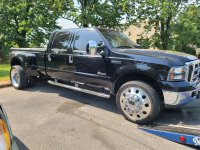
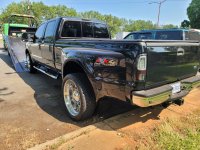
Same for my '91 Accord, stock tire size is a 195/60/15. I put a 195/50/15 on the rear. 10% difference in sidewall height, and the handling is drastically different at factory pressure (29psi iirc)
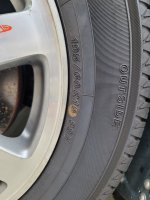
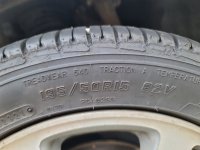
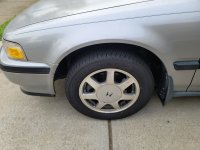
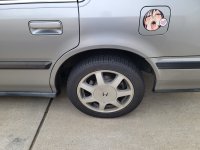
A stiffer side wall can accomplish the same thing of "less tire deflection/deformation" such as run flat tires, they are notorious for a stiff ride because the sidewalls aren't made to compress as much, so they drive like their on rails.
Comparing the factory 265/70/17 tire size on my '03 2500 too a new factory tire size of a later model 2500, 275/70/18, there isn't much of a difference in terms of side wall height.

4% difference on width and sidewall for a 10mm increase in section width.
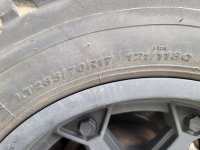

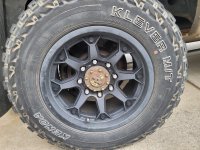
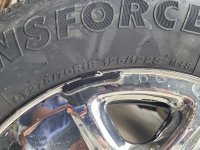

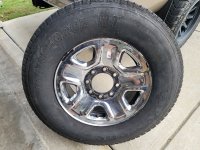
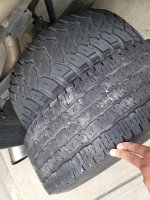
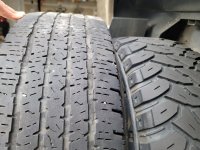
Even with the same wheel size the sidewall and width difference doesn't change.

I run a 285/70/17 front tire and a factory 265/70/17. Front 285 is on a OEM 7.5" width wheel compared to the Rear 265 on a 9" width aftermarket wheel with more negative offset. Both Load E with a 121 LI, the rear Kenda 265(3197lb) tire has a higher max load than the front Toyo 285(3195lb). The rear Kenda is an MT tire, the front Toyo is an AT.
I don't think the tire size is as important as people think it is when it comes to load, for comfort and the wheel being physically able to roll over things easier, yes I would agree a larger wheel/tire size is better. Evidence being commercial van tires, often times they are physically smaller than most LT Truck tire sizes or even passenger tire sizes but they have a much higher max load/ carrying capacity. Think Transit van and Sprinter van tire sizes.
Load capacity comes down to the construction of the tire itself from the manufacturers intended purpose of the tire. For example I saw a steal of a deal($120) on 2 new 195/60/15 Yokohama tires for my '91 Accord, but they were UHP Summer tires. Factory size but they'd handle much differently, they had an A temperature rating but what's to say the mfg. didn't use one mixture or type of rubber compound on the tread compared to the sidewalls? The ratings on tires are subject to the mfg. and their testing.
Load capacity isn't in an exclusive linear relationship with tire size, at least for tires of this scale. Tires of the same size and same load capacity can drive differently from tread compound alone. Keep in mind truck tires for Light and HD trucks have deeper tread blocks aswell. They have a break in period before they aren't as "squirmy"



It's no secret that the less side wall you have paired with a larger wheel the more the vehicle will handle like its on rails.
Towed this F350 DRW a while back that had 24.5s wrapped in Atturo AZ800s, I knew the tires by tread pattern because I had them on my '14 5.7 1500, they grip and handle very well. This 350 was well over weight capacity for the tires. It probably rode like a train.



Same for my '91 Accord, stock tire size is a 195/60/15. I put a 195/50/15 on the rear. 10% difference in sidewall height, and the handling is drastically different at factory pressure (29psi iirc)




A stiffer side wall can accomplish the same thing of "less tire deflection/deformation" such as run flat tires, they are notorious for a stiff ride because the sidewalls aren't made to compress as much, so they drive like their on rails.
Comparing the factory 265/70/17 tire size on my '03 2500 too a new factory tire size of a later model 2500, 275/70/18, there isn't much of a difference in terms of side wall height.
4% difference on width and sidewall for a 10mm increase in section width.








Even with the same wheel size the sidewall and width difference doesn't change.
I run a 285/70/17 front tire and a factory 265/70/17. Front 285 is on a OEM 7.5" width wheel compared to the Rear 265 on a 9" width aftermarket wheel with more negative offset. Both Load E with a 121 LI, the rear Kenda 265(3197lb) tire has a higher max load than the front Toyo 285(3195lb). The rear Kenda is an MT tire, the front Toyo is an AT.
I don't think the tire size is as important as people think it is when it comes to load, for comfort and the wheel being physically able to roll over things easier, yes I would agree a larger wheel/tire size is better. Evidence being commercial van tires, often times they are physically smaller than most LT Truck tire sizes or even passenger tire sizes but they have a much higher max load/ carrying capacity. Think Transit van and Sprinter van tire sizes.
Load capacity comes down to the construction of the tire itself from the manufacturers intended purpose of the tire. For example I saw a steal of a deal($120) on 2 new 195/60/15 Yokohama tires for my '91 Accord, but they were UHP Summer tires. Factory size but they'd handle much differently, they had an A temperature rating but what's to say the mfg. didn't use one mixture or type of rubber compound on the tread compared to the sidewalls? The ratings on tires are subject to the mfg. and their testing.
Load capacity isn't in an exclusive linear relationship with tire size, at least for tires of this scale. Tires of the same size and same load capacity can drive differently from tread compound alone. Keep in mind truck tires for Light and HD trucks have deeper tread blocks aswell. They have a break in period before they aren't as "squirmy"
AH64ID
TDR MEMBER
Evidence being commercial van tires, often times they are physically smaller than most LT Truck tire sizes or even passenger tire sizes but they have a much higher max load/ carrying capacity. Think Transit van and Sprinter van tire sizes.
Can you provide some examples??
I’m not sure I’ve ever seen any tires that meet what you’re claiming.
When it comes to tires the higher volume of air they hold the more weight they can hold.
Darkbloodmon
TDR MEMBER
Can you provide some examples??
I’m not sure I’ve ever seen any tires that meet what you’re claiming.
When it comes to tires the higher volume of air they hold the more weight they can hold.
Quick search for a 2010 Mercedes 2500 Sprinter Van Factory tire size. 12 ply, 123 LI, 3417lb max load, 245/75/16
alot of them at least for this vehicles sizing 16" rim are in the 120 LI range which is fairly comparable, given some of these vans have DRW axles.
Darkbloodmon
TDR MEMBER
Using just about any site you can search by load index and rim size. There are a variety of options out there for 17" wheels and below. I just searched on tires easy for 125 LI in a 17" alot of hits came up for 35" RT,MT, or AT tires. If you dial the load index back a bit to the 120-121 range the hits grow.
But to be realistic the load index is a ceiling, Max load typically correlates to max pressure. Max tire pressures are rarely recommended for these trucks. I run 45psi R, 55psi F when the door sticker calls for 60/70.
The Atturo AZ800 skinnys on that F350 had specs somewhere around this

But to be realistic the load index is a ceiling, Max load typically correlates to max pressure. Max tire pressures are rarely recommended for these trucks. I run 45psi R, 55psi F when the door sticker calls for 60/70.
The Atturo AZ800 skinnys on that F350 had specs somewhere around this
AH64ID
TDR MEMBER
Max pressure always, always, means max load.. not typically. Depending on the axle ratings max pressure is often recommended for max load on HD truck rear axles.
A quick search does show that the 2010 Sprinter 2500 has 245/75R16, but not in a 12PR. The OEM tire has a 120LI rating.
An F350 with a 50psi 96 LI tire… um, no… not even close. An F350 couldn’t run that tire empty with only 3,130/axle worth of tires.
I’ll ask again, can you show me a smaller tire with a “much” higher rating?
A quick search does show that the 2010 Sprinter 2500 has 245/75R16, but not in a 12PR. The OEM tire has a 120LI rating.
An F350 with a 50psi 96 LI tire… um, no… not even close. An F350 couldn’t run that tire empty with only 3,130/axle worth of tires.
I’ll ask again, can you show me a smaller tire with a “much” higher rating?
- Status
- Not open for further replies.

Issue 128 – Digital Version
Digital Magazines
FREE!
TDR Test Drive - Digital Edition
Renew
Subscribe
Gift Subscriptions

Back Issues
Subscription Status
Address Change Form
Buyer's Guides
Ram Diagnostic Trouble Codes
The Perfect Collection
The Perfect Collection Vol. II
TSB Updates
Dodge/Cummins Historical Overview
Cameron Collection
What Makes Us Tick?
Product Showcase
Advertising

Turbo Diesel Register

Issue 128 – Digital Version
Digital Magazines
FREE!
TDR Test Drive - Digital Edition
Renew
Subscribe
Gift Subscriptions

Back Issues
Subscription Status
Address Change Form
Buyer's Guides
Ram Diagnostic Trouble Codes
The Perfect Collection
The Perfect Collection Vol. II
TSB Updates
Dodge/Cummins Historical Overview
Cameron Collection
What Makes Us Tick?
Product Showcase
Advertising



